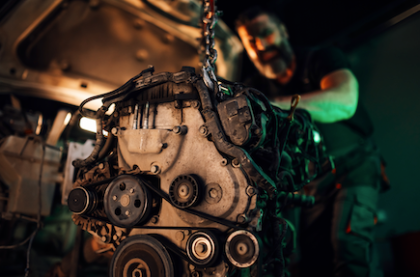INDEPENDENT DEALER
Frederick, MD & Hagerstown | (301) 416-0575
OUR BLOG
Hydrolocking is one of the most serious mechanical issues a car can face. It can turn a short drive through standing water into a multi-thousand-dollar repair. Learn all about hydrolocking in this post by Alf Marketing in Frederick, MD.

Your vehicle’s engine is a finely tuned machine, designed to compress air and fuel inside its cylinders to generate power. But there’s one thing it should never try to compress: water. When water enters the engine’s combustion chamber and prevents the piston from completing its stroke, it results in a mechanical failure known as engine hydrolocking—and it’s one of the most damaging things that can happen under the hood.
Being aware of the situation can help you avoid it more effectively. To help you out, this post will go over a closer look at what hydrolocking is, how it happens, and what it can do to your engine.
Maintaining your engine perfectly can help you avoid serious mechanical issues. Call Alf Marketing in Frederick, MD at (301) 416-0575 or visit AMSOIL's online store to place an order for the best and most effective synthetic oil to ensure your engine's well-being.
All About Hydrolocking
What Is Engine Hydrolocking?
“Hydrolock” is short for hydraulic lock, a term that describes what happens when a liquid (in this case, water) enters the engine cylinders. Internal combustion engines are built to compress a mix of air and fuel—not liquid. Since water doesn't compress, when the piston moves upward to complete the compression stroke, it hits resistance. With nowhere for the water to go, the piston can’t complete its movement, and the engine locks up.
This sudden stoppage can result in bent or broken connecting rods, damaged pistons, cracked cylinder walls, or even a destroyed engine block.
How Does Water Get Into the Engine?
Hydrolocking often happens in wet driving conditions, but there are a few common scenarios:
- Driving through deep water: Flooded streets, large puddles, or off-road trails with water crossings can send water into your engine’s air intake.
- Poorly designed or installed cold air intakes: Some aftermarket intakes are lower to the ground and more prone to sucking in water.
- Coolant leaks: A failed head gasket or cracked engine block can allow coolant to leak into the cylinders, leading to a slow form of hydrolocking.
- Fuel contamination: Though rare, a significant amount of water in the fuel can also cause issues during combustion.
A strong and healthy engine needs a strong and healthy motor oil. Feed yours with AMSOIL 20W-50 Synthetic V-Twin Motorcycle Oil, the best synthetic oil in Frederick, MD.
What Are the Signs of a Hydrolocked Engine?
Hydrolocking often happens suddenly, especially in the case of water ingestion. Here are some symptoms to watch for:
- Sudden engine stall, especially after driving through water
- Loud knocking or banging sounds
- The engine won’t turn over or cranks slowly
- Visible water in the air intake or engine compartment
- Bent or broken engine parts if disassembled
If you experience any of these symptoms after driving through water, do not attempt to restart the engine. This can cause even more damage.
Can a Hydrlocked Engine Be Saved?
Whether a hydrolocked engine can be repaired depends on how much water entered and how quickly you respond.
- Minor hydrolock: If the engine stalled immediately but no internal parts were damaged, a technician may be able to remove the spark plugs, drain the water, and restore function.
- Severe hydrolock: If internal components are bent or broken, you could be looking at a full engine rebuild or replacement—both expensive repairs.
The sooner you stop the engine and get it inspected, the better your chances of minimizing the damage.
How to Prevent Engine Hydrolocking
The best way to avoid hydrolocking is to keep your engine safe from water and other fluids:
- Avoid deep water: If a road looks flooded or questionable, turn around. Just a few inches of water can be enough to cause hydrolocking.
- Be careful with aftermarket mods: Cold air intakes can improve performance, but if placed too low, they increase the risk of drawing in water.
- Maintain your cooling system: Fix leaks promptly and monitor coolant levels to prevent internal fluid intrusion.
- Keep an eye on the forecast: During heavy rains, flash floods can appear quickly. Stay informed and cautious when driving.